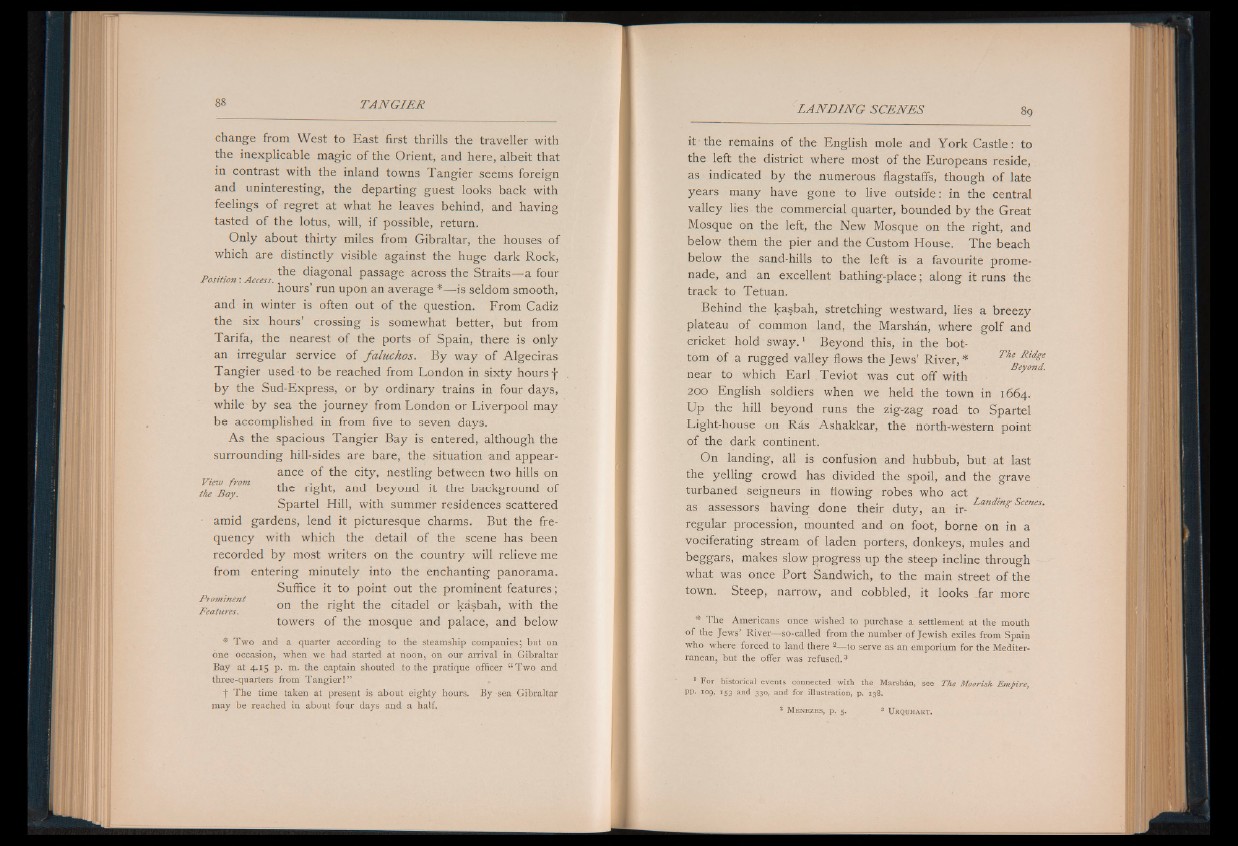
change from West to East first thrills the traveller with
the inexplicable magic of the Orient, and here, albeit that
in contrast with the inland towns Tangier seems foreign
and uninteresting, the departing guest looks back with
feelings o f regret at what he leaves behind, and having
tasted of the lotus, will, if possible, return.
Only about thirty miles from Gibraltar, the houses of
which are distinctly visible against the huge dark Rock,
P o s i t io n -A c s t^le diagonal passage across the Straits— a four
hours’ run upon an average *— is seldom smooth,
and in winter is often out of the question. From Cadiz
the six hours’ crossing is somewhat better, but from
Tarifa, the nearest of the ports of Spain, there is only
an irregular service of faluchos. By way of Algeciras
Tangier used-to be reached from London in sixty hours f
by the Sud-Express, or by ordinary trains in four days,
while by sea the journey from London or Liverpool may
be accomplished in from five to seven days.
As the spacious Tangier Bay is entered, although the
surrounding hill-sides are bare, the situation and appearance
of the city, nestling between two hills on
Ait^Bay0"1 right, and beyond it the background of
Spartel Hill, with summer residences scattered
• amid gardens, lend it picturesque charms. But the frequency
with which the detail o f the scene has been
recorded by most writers on the country will relieve me
from entering minutely into the enchanting panorama.
Suffice it to point out the prominent features;
Prominent on ^he right the citadel or kasbah, with the
features. 0
towers of the mosque and palace, and below
* Two and a quarter according to the steamship companies \ but on
one occasion, when we had started at noon, on our arrival in Gibraltar
Bay at 4.15 p. m. the captain shouted to the pratique officer “ Two and
three-quarters from Tangier!”
t The time taken at present is about eighty hours. By sea Gibraltar
may be reached in about four days and a half.
it the remains of the English mole and York Castle: to
the left the district where most of the Europeans reside,
as indicated by the numerous flagstaff's, though o f late
years many have gone to live outside: in the central
valley lies the commercial quarter, bounded by the Great
Mosque on the left, the New Mosque on the right, and
below them the pier and the Custom House. The beach
below the sand-hills to the left is a favourite promenade,
and an excellent bathing-place; along it runs the
track to Tetuan.
Behind the kasbah, stretching westward, lies a breezy
plateau of common land, the Marshan, where golf and
cricket hold sway.1 Beyond this, in the bottom
of a rugged valley flows the Tews’ River,* The Rldge
' Beyond.
near to which Earl Teviot was cut off with
200 English soldiers when we held the town in 1664.
Up the hill beyond runs the zig-zag road to Spartel
Light-house on Ras Ashakkar, the north-western point
of the dark continent.
On landing, all is confusion and hubbub, but at last
the yelling crowd has divided the spoil, and the grave
turbaned seigneurs in flowing robes who act
as assessors having done their duty, an ir- Landmg Scenes-
regular procession, mounted and on foot, borne on in a
vociferating stream of laden porters, donkeys, mules and
beggars, makes slow progress up the steep incline through
what was once Port Sandwich, to the main street o f the
town. Steep, narrow, and cobbled, it looks .far more
* The Americans once wished to purchase a settlement at the mouth
of the Jews’ River— so-called from the number of Jewish exiles from Spain
who where forced to land there 2— to serve as an emporium for the Mediterranean,
but the offer was refused.3
1 For historical events connected with the Marshan, see The Moorish Empire,
pp. 109, 153 and 330, and for illustration, p. 138.
* M e n e z e s , p . 5 . 3 U r q u h a r t .